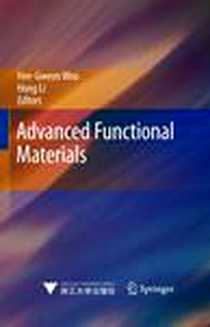《先进功能材料》
《先进功能材料》
出版时间:2011-3
出版社:禹熙权 浙江大学出版社 (2011-03出版)
作者:禹熙权
页数:227
《先进功能材料》内容概要[E]
With recent developments in the polymer, ceramic, sensor, and fuel cell technology, a range of novel materials have been manufactured for advanced, compact, and electronic industry. Polymers, silicon, energy materials have received much attention in recent years. Advanced Func-tional Materials gives the most recent research results on polymer, fine ceramics, sensor, and green fuel cells. The content of this book, mainly based on the authors' recent research results, covers a broad spectrum including: the advanced inorganic-organic-hybrid polymeric materials,high functional sensor, and microbial fuel cells. The book is suitable for the researchers working in the areas of polymer, nanotechnology, ceramic engineering, engineering thermoplastic, energy and power engineering,chemical engineering and materials, etc.
《先进功能材料》作者简介[E]
Hee-Gweon Woo is a professor at the Department of Chemistry, Chonnam National University, the Republic of Korea. Hong Li is a professor at the Institute of Polymer Chemistry, Nankai University, China.
《先进功能材料》书籍目录[E]
1 Polyimides and High Performance Organic Polymers 1.1 Introduction 1.2 Aromatic Polyimides
1.2.1 Polyimides
1.2.2 Classification
1.2.3 Aromatic Polyimides
1.2.4 Synthesis of Aromatic Polyimides
1.2.5 Properties of Aromatic Polyimides
1.2.6 Applications for Aromatic Polyimides 1.3 Aliphatic Polyimides
1.3.1 Monomers for Fully Aliphatic Polyimides
1.3.2 Synthesis of Fully Aliphatic Polyimides
1.3.3 Structural Confirmation of Fully Aliphatic Polyimides
1.3.4 Properties of Fully Aliphatic Polyimides 1.4 Polyimides for Organic Light-Emitting Devices and Flexible Substrates
1.4.1 Semi-conducting Polyimides
1.4.2 Polyimides as Plastic Substrate for the Flexible OLED 1.5 Polyimide-Based Nanohybrids 1.6 Other General High Performance Polymers
1.6.1 Polyetheretherketon (PEEK)
1.6.2 Polysulphone (PSU)
1.6.3 Polysulfides
1.6.4 Polycarbonates (PC)
1.6.5 Polyamides (PA)
1.6.6 Poly(Butylene Terephthalate) (PBT)
1.6.7 Poly(Phenylene Oxides)
1.6.8 Polynorbornene (PNB) 1.7 Summary References2 Advanced Biodegradable Organic Polymers 2.1 Introduction 2.2 Synthesis of Biodegradable Polymers by Polycondensation
2.2.1 General Polycondensation Technique
2.2.2 Post Polycondensation Technique
2.2.3 Chain-Extension Technique
2.2.4 Enzyme-Catalyzed Polycondensation 2.3 Synthesis of Biodegradable Polymers by Ring-Opening Polymerization
2.3.1 Monomers
2.3.2 Polymerization with Metal Catalysts
2.3.3 Polymerization Using Metal-Free Organic Catalysts
2.3.4 Enzyme-Catalyzed Ring-Opening Polymerization 2.4 Concluding Remarks References3 High Functional Inorganic Polymers Containing Main Group 13 - 16 Elements in the Polymer Backbone Chain 3.1 Introduction 3.2 Group 14 Inorganic Polymers: Polysilanes, Polygermanes, Polystannanes, and their Copolymers
3.2.1 Dehydrocatenation of Group 14 Hydrides to Polymers
3.2.2 Redistributive Catenation of Group 14 Hydrides to Polymers.
3.2.3 Exhaustive Hydrosilylation, Hydrogermylation and Hydrostannylation of Group 14 Hydrides on Vinyl Derivatives.
3.2.4 Formation of Polysilane-Metal Nanoparticle Composites 3.3 Group 13 Inorganic Polymers: Polyborazines 3.4 Group 15 Inorganic Polymers: Polyphosphazenes 3.5 Group 16 Inorganic Polymers: Polysulfur and Poly(sulfur nitride) 3.6 Summary References4 Preparation and Applications of Ceramic Composite Phases from Inorganic Polymers 4.1 Introduction 4.2 Preparation of Composite Phases from Inorganic Polymers
4.2.1 Si-C-B-N Ceramics via Hydroboration from Borazine Derivatives and Trivinylcyclotrisilazane
4.2.2 SiC/MoSi2 Ceramic Composites Prepared by Polymer Pyrolysis
2.2.3 Ti-B-N Composite from a Hybrid Precursor of Polybomzine' and Till2
4.2.4 A1-B-N Nanocomposite from Polyborazine and A1 Metal..
4.2.5 A1-Cr-Phosphates as Low Temperature Curable Binders.. 4.3 Applications of Preceramic Polymers
4.3.1 Preparation of Carbon Fiber Reinforced BN Matrix Composite..
4.3.2 BN Film by Spin-Coating Process of a Polymeric Precursor..
4.3.3 Fabrication of SiC-Based Ceramic Microstructures 4.4 Summary References 5 Chemical and Biological Sensors Based on Porous Silicon Nanomaterials 5.1 Introduction 5.2 Interferometric Sensors Based on Porous Silicon Nanomaterials
5.2.1 Fabrication of Porous Silicon
5.2.2 Chemical Sensing Application of Porous Silicon
5.2.3 Biological Sensing Application of Porous Silicon 5.3 Summary References6 Microbial Fuel Cells as the Real Source of Sustainable Energy 6.1 Introduction 6.2 Configurations and Designs of Microbial Fuel Cells
6.2.1 MFC Components
6.2.2 Two-Chambered MFCs
6.2.3 Single-Chambered MFCs
6.2.4 Up-Flow Mode MFCs
6.2.5 Stacked MFCs 6.3 Electrode Materials and Catalysts
6.3.1 Electrode Materials
6.3.2 Cathodic Catalysts 6.4 Performance of Microbial Fuel Cells
6.4.1 Parameters Defining the Performance of MFCs
6.4.2 Effects of Conditions When Operating MFCs 6.5 Metabolism in Microbial Fuel Cells 6.6 Applications 6.7 SummaryReferencesIndex
《先进功能材料》编辑推荐[E]
There are great interests in six advanced technologies: nano-technology, bio-based technology, sensor technology, energy-based technology, high performance material-based technology, and fuel cell technology. During the past decades major progress in the synthesis, characterization, and applications of functional polymers has been accomplished along with the recent development of nano-bioscience and environment technology. This monograph titled Advanced Functional Materials contains six chapters spanning from polymers to ceramics, sensor, and to fuel cell: high performance organic polymers, biodegradable organic polymers,inorganic polymers, ceramic composite formation, sensor, and fuel cell.